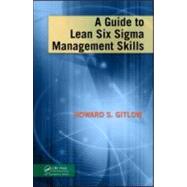
Note: Supplemental materials are not guaranteed with Rental or Used book purchases.
Purchase Benefits
Looking to rent a book? Rent A Guide to Lean Six Sigma Management Skills [ISBN: 9781420084160] for the semester, quarter, and short term or search our site for other textbooks by Gitlow; Howard S. Renting a textbook can save you up to 90% from the cost of buying.
| Preface | p. xi |
| Acknowledgments | p. xiii |
| About the Author | p. xv |
| The Meaning and Purpose of Work | p. 1 |
| Traditional View of Work | p. 1 |
| Doing Your Job | p. 1 |
| Reacting to Daily Crisis | p. 2 |
| Lean Six Sigma View of Work | p. 2 |
| A New Perspective on Life and Work | p. 3 |
| Principle 1: Life and Business Are Processes | p. 3 |
| Principle 2: All Processes Exhibit Variation | p. 4 |
| Principle 3: Two Causes of Variation Exist in Many Processes | p. 5 |
| Principle 4: Life and Business in Stable and Unstable Processes Are Different | p. 9 |
| Principle 5: Continuous Improvement Is Economical, Absent Capital Investment | p. 11 |
| Principle 6: Many Processes Exhibit Waste | p. 12 |
| Principle 7: Effective Communication Requires Operational Definitions | p. 13 |
| Principle 8: Expansion of Knowledge Requires Theory | p. 14 |
| Principle 9: Planning Requires Stability | p. 15 |
| Conclusion | p. 16 |
| Doing Your Job and Improving Your Job | p. 16 |
| Principle 1 | p. 16 |
| Principle 2 | p. 20 |
| Principle 3 | p. 20 |
| Principle 4 | p. 25 |
| Principle 5 | p. 26 |
| Principle 6 | p. 27 |
| Principle 7 | p. 53 |
| Principle 8 | p. 54 |
| Principle 9 | p. 70 |
| More on Common and Special Causes (Improve the Process to Eliminate Daily Crises) | p. 70 |
| The Funnel Experiment | p. 72 |
| The Red Bead Experiment | p. 82 |
| Feedback Loops | p. 85 |
| Four Questions You May Ask about Lean Six Sigma Management | p. 86 |
| Motivation and Compensation | p. 89 |
| Traditional View: Extrinsic Motivators | p. 89 |
| Lean Six Sigma View: Intrinsic and Extrinsic Motivators | p. 91 |
| Background | p. 91 |
| Lean Six Sigma and Performance Appraisal | p. 91 |
| The Revised Performance Appraisal System | p. 99 |
| Conclusion | p. 101 |
| Working Conditions | p. 103 |
| Introduction | p. 103 |
| Poor Training | p. 104 |
| Slogans, Exhortations, and Targets That Demand Higher Levels of Productivity | p. 106 |
| Work Standards (Quotas and Piecework) on the Factory Floor | p. 107 |
| Fear | p. 108 |
| Barriers That Rob the Hourly Worker of His Right to Pride of Workmanship | p. 109 |
| Lack of Education and Self-Improvement Efforts | p. 110 |
| Behavior and Relationships | p. 113 |
| Types of Individual Behavior | p. 113 |
| Purpose of Assertive Behavior | p. 114 |
| Steps toward Assertive Behavior | p. 114 |
| Step 1 | p. 114 |
| Step 2 | p. 119 |
| Step 3 | p. 120 |
| Step 4 | p. 123 |
| Personal Discipline | p. 123 |
| Debunking Myth 1 | p. 124 |
| Debunking Myth 2 | p. 124 |
| Debunking Myth 3 | p. 124 |
| Debunking Myth 4 | p. 125 |
| Debunking Myth 5 | p. 125 |
| Selected Types of Relationships | p. 126 |
| Boss-Subordinate Relationships | p. 126 |
| Co-Worker Relationships | p. 129 |
| Selected Techniques for Improving Relationships | p. 130 |
| Other People's Views (OPV) | p. 130 |
| Consequences & Sequel (C&S) | p. 131 |
| Alternatives, Possibilities, and Choices (APC) | p. 131 |
| Improving Team Behavior | p. 133 |
| Stages of Team Behavior | p. 133 |
| Escalating "I" Messages for Improving Team Behavior | p. 134 |
| Conflict Resolution Skills for Improving Team Behavior | p. 135 |
| Step 1: View the Participants in the Conflict as Equals Trying to Solve a Problem to Their Mutual Advantage | p. 136 |
| Step 2: Identify the Viewpoints of All Participants of the Conflict | p. 136 |
| Step 3: Develop Alternative Solutions for the Conflict That Result in "Win-Win" Situations, or at Least "No Lose" Situations | p. 137 |
| Step 4: All Participants in the Conflict Review the "Win-Win" Solutions or Negotiate the Differences in Their Solutions to Create "No Lose" Solutions to the Conflict | p. 139 |
| Step 5: Avoid the Common Pitfalls of "No Lose" Solutions | p. 139 |
| Step 6: Try Out the "Win-Win" Solution or the Best "No Lose" Solution for a Limited Time Period | p. 140 |
| p. 141 | |
| Bibliography | p. 143 |
| Index | p. 145 |
| Table of Contents provided by Ingram. All Rights Reserved. |
The New copy of this book will include any supplemental materials advertised. Please check the title of the book to determine if it should include any access cards, study guides, lab manuals, CDs, etc.
The Used, Rental and eBook copies of this book are not guaranteed to include any supplemental materials. Typically, only the book itself is included. This is true even if the title states it includes any access cards, study guides, lab manuals, CDs, etc.